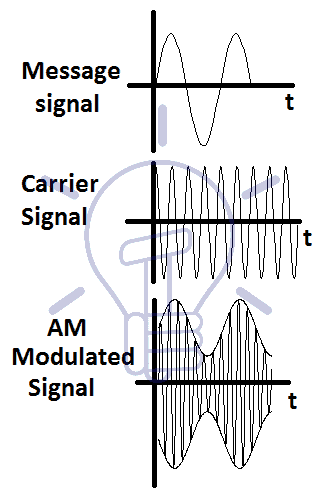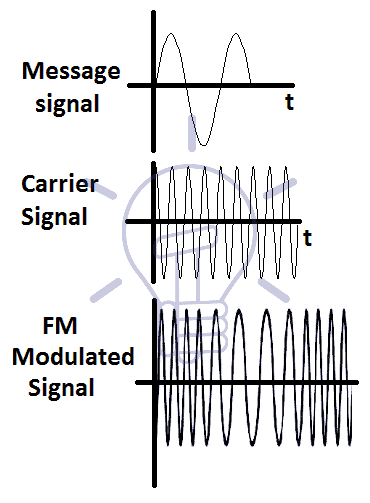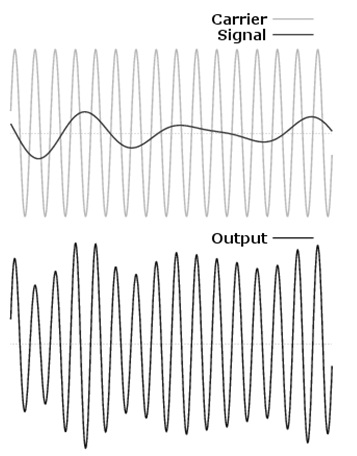Name and Explain Three Different Analog Modulation Schemes
In analog modulation the analog signal sinusoidal signal is used as a carrier signal that modulates the analog message signal. In AM the value between the max min is considered to be applicable.

What Is Modulation Classification And Types Of Analog Modulation
This is the signal to be transmitted to the receiver.

. Amplitude modulation is a process by which the wave signal is transmitted by modulating the amplitude of the signal. It is often called AM and is commonly used in transmitting a piece of information through a radio carrier wave. The modulation concept comes into consideration when the signal needs to be transmitted over a long distance through an antenna.
For binary signal it has only two level either high or logic 1 or low or logic 0. The other types of modulation techniques used in the communication system are. Message signals also known as baseband signals are the band of frequencies representing the original signal.
Currently this technique is used in. Analog Modulation 61 Continuous wave modulation The carrier signal used for modulating the message signal is. The modulation process places analog or digital signal.
Modulations are one of the fundamental technologies. The news today because newer algorithms that take advantage of. This frequency modulation needs a higher bandwidth range which is almost 15 times ahead of the narrow band frequency modulation.
The first scheme is called Amplitude Modulation and the second two are called Angle Modulation schemes. Information onto sinewave carriers while demodulation reverses the. The signal has varying amplitude or phase or frequency.
ASK or Amplitude shift Key. Amplitude modulation AM is a technique used in electronic communication most commonly for transmitting information via a radio carrier wave. The modulation scheme is mainly three types.
Digital modulation is the term refers to modulation of the digital signals. PSK or Phase shift key. Analog communication means that the information is transmitted in the form of a continuous signal such as a sound wave.
Here we discuss analog modulation techniques. As shown here input signal is digital while carrier signal is in analog form. Channel can be of three types.
Logic 1 or logic 0 carrier frequency is manipulated before transmission. In analog modulation the characteristics amplitude frequency or phase of the carrier signal is varied in accordance with the amplitude of the message signal. If noise enters into a system it persists and gets carried up to the end receiver.
This modulation is generally needed when a bandpass channel is required. This paper is about the different types of modulation schemes like AM FM PM PAM PWM PPM PCM etc used in the communication system and their importance. This type of modulation is used for signal generation in al synthesizers such as the Yamaha DX7 to implement FM synthesis.
For a signal to be transmitted to a distance without the effect of any external interferences or noise addition and without getting faded away it has to undergo a process called as Modulation. Types of Analog Modulation. The amplitude the phase and frequency.
The modulation concept makes the communication purely wireless and mobileAnd because of modulation we can now roam freely without the fear of getting out of. A series of 0s and 1s. Amplitude modulation is mostly used in the form of electronic communication.
Pulse Width Modulation PWM or Pulse Duration Modulation PDM or Pulse Time Modulation PTM is an analog modulating scheme in which the duration or width or time of the pulse carrier varies proportional to the instantaneous amplitude of the message signal. In digital modulation the information signal is digital. Antenna helps transmit the signal over long distance.
It is a signal that can only take up specific valuesDigital signals use binary codes. In digital modulation DM the input must be the data in the form of digital. The generic name for this family of modulation is Frequency Shift.
It is clear that these two communications systems will require different properties from a modulation scheme. Frequency of such a signal is usually low. In analog modulation AM the input must be in the form of analog.
Year - 2014 ISSN 2319 9202 6. AM works by varying the strength of the transmitted signal in relation to the information being sent. Amplitude modulated signal and frequency modulated signals are the examples of analog communication.
Differential quadrature phase shift keying. The figure-2 depicts this type of modulation with ASK as example. It is a process by virtue of which a characteristic of carrier wave is varied according to the instantaneous amplitude of the modulating signal.
Therefore Analog modulation includes AM FM and PM and these are more sensitive to noise. The larger the number of 0s and 1s used to represent the signal in a given time interval the more is the number of values that the signal could take. Here based on digital signal input ie.
Coding is not applied to the signal as in case of digital data. An AM signal can signify any value in a range. The basic idea here is to superimpose the message signal in analog form on a carrier which is a sinusoid of the form There are three quantities that can be varied in proportion to the modulating signal.
Binary phase shift keying. Simulation is used to compare the performance and tradeoffs of three popular systems MSK GMSK and BPSK including analysis of key parameters such as occupied. What is Digital Modulation.
Process at the receiving end. Analog-to-analog conversion or modulation is the representation of analog information by an analog signal. A DM signal can only signify with a set of discrete values.
There are four basic types of. Analog Communication - Modulation. Modulation schemes are very much in.
FSK or Frequency shift key. It improves the strength of the signal without disturbing the parameters of the original signal. There are three types of Modulation.
The width of the pulse varies in this method but the amplitude of the signal remains. Digital modulation in somewhat similar to the analog modulation except base band signal is of discrete amplitude level.

What Is Modulation Classification And Types Of Analog Modulation

Analog Modulation Types Derivatives Advantages Applications

Analog Communication Modulation

What Is Modulation Classification And Types Of Analog Modulation
No comments for "Name and Explain Three Different Analog Modulation Schemes"
Post a Comment